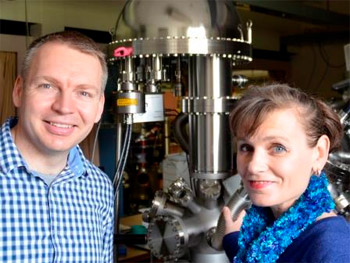Whispering Implants

Whispering Implants
A Braille-like method that enables medical implants to communicate with a patient's cells could help reduce biomedical and prosthetic device failure rates, according to University of Sydney researchers.
An international team including the University of Sydney's Dr Wojciech Chrzanowski, Faculty of Pharmacy, Professor Marcela Bilek, School of Physics, and Professor Hae-Won Kim from Dankook University, South Korea combined concepts from nanotherapeutics and nanotechnology to develop the Braille-like communication capability for implant surfaces.
Results of their five-year study investigating ways to effectively stimulate the body's acceptance of the biomaterials, using an -imprinted' message on the surface of implantable devices such as artificial joints, has been published today in the prestigious journal Advanced Functional Materials.
The study focused on creating surfaces on biomaterials that can recruit relevant cells, in this case bone cells, and trigger optimal responses that functionally integrate the implant within the body.
The paper reports a dramatic increase in new bone creation when the novel hybrid -messenger' protein is correctly fastened to the implant surface.
Lead author on the paper Dr Chrzanowski, says, 'Implant rejection is due to the inability of biomaterials that are currently used to talk to the cells of nearby tissues."
Dr Chrzanowski who is also a member of the Biomedical Technology Institute in the Faculty of Engineering and Information Technologies at the University says up to 17 % per cent of implants fail, which vary between sites of implantation.
"The implantation of metal devices such as knee, hip, spinal or dental implants carries a high risk of post-operative complications. These complications are often caused by poor integration of the implant and infection," Dr Chrzanowski explains.
Professor Marcela Bilek and her team created a simple, one-step process to cloak the surface of a foreign material with the special messenger molecules so that this surface communicates effectively with living cells.
'Communicating with the body via the surface enables the implant to become integrated with local tissues, reducing the number of rejections, and dramatically improving the functionality of orthopaedic implants," states Professor Bilek.
The success of the study hinged on two innovations: 'A smart messenger protein molecule that regulates the chain of biological events form new bone, and a novel reactive nanothin interface that anchors these molecules to the implant surface in their most active configuration, "says Professor Bilek.
Korean collaborator Professor Kim agrees: "Globally these are regarded as the most dreaded complications in orthopaedics, resulting in repeat surgeries, patient distress and disability," he says.
Recent data shows the number of revision operations in Australia is steadily increasing at approximately six percent per annum.
This technology is a significant advance in the field and is now entering a pre-clinical phase towards commercialization together with our industry partner, European Spinal implant manufacturer, LfC Sp.z.o.o.
MORE



